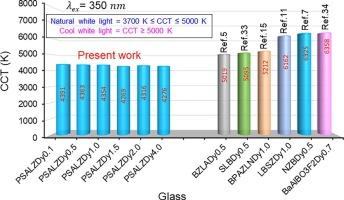Near UV excited photoluminescence studies of oxyfluoride-phosphosilicate glasses doped with various Dy3+ amounts for natural white light generation
IF 2.4
3区 化学
Q4 CHEMISTRY, PHYSICAL
引用次数: 0
Abstract
In this work, Dy3+-doped oxyfluoride-phosphosilicate glasses with (40-x)P2O5 + 10SiO2 + 10AlF3 + 20LiF + 10ZnO + 10ZnF2 + xDy2O3 (0.1 ≤ x ≤ 4.0 mol%) compositions were fabricated by melt quenching. These glasses were studied by the optical band gap (3.51˗3.28 eV) and Urbach (0.182–0.263 eV) energies. The changes in the JO parameters from Ω2 > Ω4 > Ω6 to Ω2 > Ω6 > Ω4 and Y/B ratios from 1.968 to 2.006 were observed with the addition of Dy3+. Dipole-dipole interaction and cross-relaxation channels were confirmed a reduction in decay times (437˗117 μs) and PL quenching. Emission cross-section (32.25 × 10−21 cm2), gain bandwidth (44.09 × 10−27 cm3), optical gain (19.64 × 10−24 cm2 s), and quantum efficiency (68 %) values of the optimal Dy0.5 glass are superior relative to other reports for the 4F9/2 → 6H13/2 transition, implying its potential use in yellow lasers and amplifier design. Moreover, the intense yellow emission relative to the blue band in the current glasses leads to the generation of natural white light (CCT: 4200–4400 K) upon 350 nm excitation.

掺不同Dy3+量的氟氧磷硅酸盐玻璃近紫外激发光致发光研究
本文采用熔体淬火法制备了(40-x)P2O5 + 10SiO2 + 10AlF3 + 20LiF + 10ZnO + 10ZnF2 + xDy2O3(0.1≤x≤4.0 mol%)的掺Dy3+氧氟化磷硅酸盐玻璃。通过光学带隙(3.51 - 3.28 eV)和乌尔巴赫(0.182-0.263 eV)能量对这些玻璃进行研究。从Ω2 >;Ω4比;Ω6到Ω2 >;Ω6比;添加Dy3+后,其Y/B比值为1.968 ~ 2.006。偶极子-偶极子相互作用和交叉弛豫通道在衰减时间(437 μs)和PL猝灭中得到证实。在4F9/2→6H13/2跃迁过程中,Dy0.5玻璃的发射截面(32.25 × 10−21 cm2)、增益带宽(44.09 × 10−27 cm3)、光学增益(19.64 × 10−24 cm2 s)和量子效率(68%)值均优于其他报道,表明其在黄色激光器和放大器设计中具有潜在的应用前景。此外,在现有的玻璃中,相对于蓝带,强烈的黄色发射导致在350 nm激发下产生自然白光(CCT: 4200-4400 K)。
本文章由计算机程序翻译,如有差异,请以英文原文为准。
求助全文
约1分钟内获得全文
求助全文
来源期刊

Chemical Physics
化学-物理:原子、分子和化学物理
CiteScore
4.60
自引率
4.30%
发文量
278
审稿时长
39 days
期刊介绍:
Chemical Physics publishes experimental and theoretical papers on all aspects of chemical physics. In this journal, experiments are related to theory, and in turn theoretical papers are related to present or future experiments. Subjects covered include: spectroscopy and molecular structure, interacting systems, relaxation phenomena, biological systems, materials, fundamental problems in molecular reactivity, molecular quantum theory and statistical mechanics. Computational chemistry studies of routine character are not appropriate for this journal.
 求助内容:
求助内容: 应助结果提醒方式:
应助结果提醒方式:


